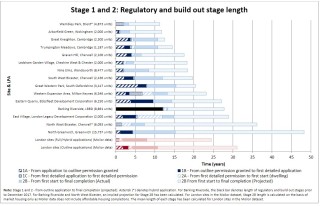That is the conclusion of a government-commissioned review of house-building and the prescribed solution is more variety of house types.
Sir Oliver Letwin was commissioned by the government to examine what could be done to speed up the slow rate of house building on major sites.
He recommends changes to the current system to ensure new homes are built faster. But he also calls for more British bricklayers to be trained to help meet government targets.
Sir Oliver Letwin’s draft analysis, published 25th June 2018, says that developers are deliberately slowing the system down by limiting the number of new built homes that are released for sale at any one time. The practice is designed to prevent a glut of new built homes driving down prices in the local market and is known as the ‘absorption rate’.
The report suggests that developers could increase the choice of design, size and tenure of new homes without impacting on the local market and therefore speed up the rate at which houses are built and sold.
The report concludes that “….to obtain more rapid building out of the largest sites we need more variety within those sites”.
The analysis also suggests a shortage of British bricklayers will have a “significant biting constraint” on government plans to boost the number of new homes built from 220,000 a year to 300,000.
To meet the shortfall the analysis calls for 15,000 more bricklayers, almost a quarter of the size of the current workforce, to be trained over the next five years.
It suggests that to “raise production of new homes from about 220,000 to about 300,000… the government and major house-builders work together … on a five-year ‘flash’ programme of pure on-the-job training”.

Sir Oliver Letwin said: “It is clear that the main cause for delay is the absorption rate. We found that if house builders were to offer more variety of homes and in more distinct settings then overall build out rates could be substantially accelerated.”
Secretary of state for communities and housing James Brokenshire said: “We want to help people onto the housing ladder, and so I would like to thank Sir Oliver and the expert panel for their excellent work. I was particularly interested to see that increasing the choice of design, size and tenure of new homes in helping to speed up build out rates and help deliver the homes we need and communities want. I look forward to receiving the final report in the autumn.”
Sir Oliver and the panel visited 15 large sites – of between 1,000 and 15,000 homes - in areas of high demand all over England. The median build-out period for these sites from the moment when the house-builder has an implementable consent is 15.5 years.
Developers have long rejected charges of land banking – that they sit on consented land without building on it. This report only partially supports their claims.
Sir Oliver Letwin writes: “In one sense, as I have argued, the major house builders are certainly “land banking”: they proceed on a large site, once that site benefits from an implementable permission, at a rate designed to protect their profits by constructing and selling homes only at a pace that matches the market’s capacity to absorb those homes at the prices determined by reference to the local second-hand market.”
Sir Oliver Letwin and his panel are expected to submit final recommendations on improving build-out rates in the autumn.
(Click on image to enlarge)
Got a story? Email news@theconstructionindex.co.uk



